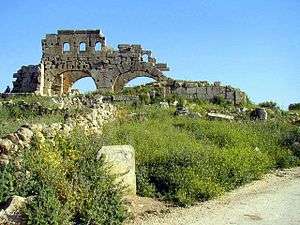Barad, Syria
Barad (Arabic: براد) is a mountainous village in northern Syria, administratively part of the Aleppo Governorate, located northwest of Aleppo. Nearby localities include Burj Abdullah to the northwest, Kimar to the north, Aqiba to the northeast and Nubl to the east. On March 21, 2018, the village came under the control of the Syrian National Army.
Barad براد | |
|---|---|
Village | |
 Ruins of the North Church AD561 at the ancient site of Barad, 2009 | |
 Barad | |
| Coordinates: 36°23′8″N 36°53′57″E | |
| Country | |
| Governorate | Aleppo |
| District | Afrin |
| Subdistrict | Afrin |
| Control | |
| Population (2004 census)[1] | |
| • Total | 1,229 |
| Time zone | UTC+2 (EET) |
| • Summer (DST) | UTC+3 (EEST) |
Population
According to the Syria Central Bureau of Statistics (CBS), Barad had a population of 1,229 in the 2004 census.[1] Although the vicinity of Barad is still populated, it is listed as one of the Dead Cities, a UNESCO World Heritage Site.[2] It is the most extensive ancient site in the area[3] with an important group of buildings dating from the Byzantine era.[4][5]
Archaeological remains
The archaeological remains in the vicinity of Barad include several old churches, an ancient monastery, a large public bathhouse, five warehouses, meeting house, a magistrate's residence, a tetrapylon, two monasteries and a cathedral. Most of these date from the Byzantine period.[4][5]
The cathedral, known as the Church of Julianos,[6] was built between 399 and 402 CE.[4] It is a large building containing a sizable bema ("elevated position") in the center of the hall which represents the centrality of Jerusalem. At the end of its wall is a book rest.[7] Of the seven churches that were built in northern Syria before 400 CE, the Church of Julianos was one of two large three-aisled basilicas; the other five were smaller, with only a single aisle.[8] The basilica itself, with the exception of the western portico section, measures about 39 metres (128 ft) in length and 27 metres (89 ft) in width. Two rows of eight columns divide the basilica into a nave and two side aisles. The church has an unusually large number of entrances, including four on the south, two on the north and three on the west side. The large courtyard that extends to the south of the basilica is marked by columns and two building complexes that were used as accommodation for monks and visitors. According to Robert Milburn, the church's architectural quality lies in its fine proportions rather than any ornamental details.[9]
A second church was built in Barad in the 6th-century.[10] The monastery, known as Qasr al-Barad, is situated about 1,200 metres (3,900 ft) southwest of the village site.[11]
On 22 March 2018, Barad was bombed by Turkish forces. Several important structures were damaged or destroyed, including the tomb of St. Maron, and the Julianos Church.[12][13]
References
- General Census of Population and Housing 2004. Syria Central Bureau of Statistics (CBS). Aleppo Governorate. (in Arabic)
- Less, 2010, p. 240.
- Verlag, 1999, p. 108.
- Ball, 2001, p. 226.
- Ball, 2001, p. 210.
- Richardson, 2004, p. 147.
- Wilkinson, 2002, p. 138.
- Trombley, 2001, p. 249.
- Milburn, 1998, p. 125.
- Trombley, 2001, p. 250.
- Burns, 2009, p. 76.
- "Turkish airstrikes 'damaged ancient Christian site' in Syria". The New Arab. 23 March 2018. Retrieved 3 May 2019.
- "Turkish warplanes destroy Brad archaeological site in Afrin". SANA. 22 March 2018. Retrieved 3 May 2019.
Bibliography
- Ball, Warwick (2001). Rome in the East. Psychology Press. ISBN 0415243572.
- Burns, Ross (2009). The Monuments of Syria. I. B. Tauris. ISBN 1845119479.
- Less, Jess (2010). Syria Handbook. Footprint Travel Guides. ISBN 1907263039.
- Richardson, Peter (2004). Building Jewish In The Roman East. Baylor University Press. ISBN 1932792015.
- Trombley, Frank R. (2001). Hellenic Religion and Christianization, C. 370-529. 2. BRILL. ISBN 0391041215.
- Milburn, Robert (1998). Early Christian Art and Architecture. University of California Press. ISBN 9780520074125.
- Verlag, Nelles (1999). Syria Lebanon (Nelles Guides). Hunter Publishing, Inc. ISBN 3886181057.
- Wilkinson, John (2002). From Synagogue to Church: The Traditional Design: Its Beginning, its Definition, its End. Psychology Press. ISBN 0700713204.

